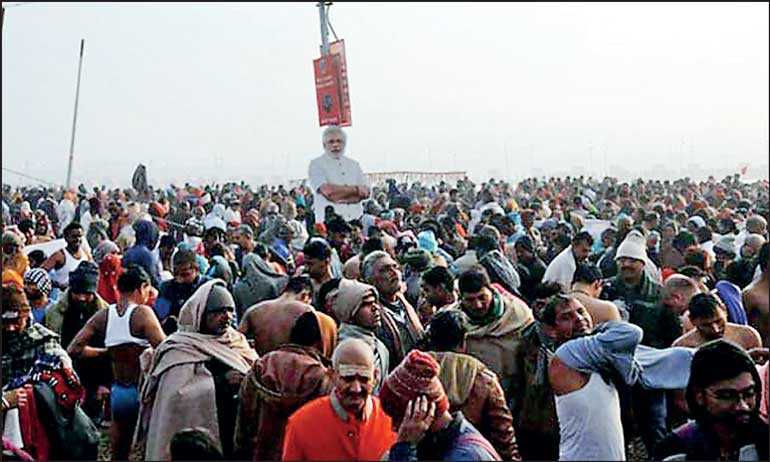Thursday Mar 13, 2025
Thursday Mar 13, 2025
Tuesday, 15 January 2019 00:00 - - {{hitsCtrl.values.hits}}

PRAYAGRAJ, India (Reuters): Pilgrims from across the world are gathering in India for the Kumbh Mela, a heady mix of spirituality, politics and tourism that begins on Tuesday, garnering extra attention ahead of a general election in the Hindu-majority country this year.
During the eight-week festival at Prayagraj in Uttar Pradesh, authorities expect up to 150 million people, including a million foreign visitors, to bathe at the confluence of the Ganges, the Yamuna, and a mythical third river, the Saraswati.
Devout Hindus believe that bathing in the waters of the Ganges absolves people of sins and bathing at the time of the Kumbh Mela, or the “festival of the pot”, brings salvation from the cycle of life and death.
“Kumbh is a conglomeration of spiritual consciousness and cultural heritage,” Mahesh Sharma, who heads the culture ministry, said in a statement.
“We are also showcasing here India’s rich traditions, as visualised by Prime Minister Narendra Modi.”
On Tuesday millions of pilgrims, led by naked, ash-smeared ascetics, some of whom live in caves, will plunge themselves into the icy waters during the first Shahi Snan, or Royal Bath, that begins around 4 a.m. (2230 GMT).
With less than 24 hours until the festival starts, the last of the arriving ascetics paraded towards temporary ashrams, or monasteries, built of corrugated steel and canvas on the eastern banks of the Ganges, many decked in fairy lights.
Pilgrims poured in to the site, which is closed to traffic around bathing days, carrying bundles on their heads, while vendors peddled neon balloons and cotton candy, as securitymen stood guard, with priests and armed police seated side-by-side.
Authorities have set up temporary bridges, 600 mass kitchens and more than 100,000 portable toilets in a pop-up city at the confluence of the rivers, which is known as the sangam.
Those with cash can make their pick of luxury campsites on the river banks that offer ayurvedic spas and yoga that cost up to 32,000 rupees ($454.09) each night.
Most of the pilgrims make do with more modest lodgings, sleeping in vast tents or out in the open.
“I don’t know where I will stay yet, but you do not often get to meet these saints and sadhus,” said Rajendra Singh, a retired soldier now working as a security guard, who rode a bus from the state capital, Lucknow, about 200 km (124 miles) away.
Political pilgrimage
This year’s event comes at a critical time for Modi’s Hindu nationalist Bharatiya Janata Party (BJP), expected to face a tough contest in a general election due to be held by May.
It lost power in three key states in assembly elections in December, and will want to avoid a similar result during the general election in Uttar Pradesh, a state of 220 million where a good showing can often decide the contest.
The state’s chief minister, Yogi Adityanath, is a firebrand Hindu monk from the BJP, who has championed policies that play to the party’s core Hindu base.
This year Adityanath has transformed a smaller Ardh, or “half” Kumbh Mela, into a full version of the festival.
He has also lobbied for a controversial Hindu temple on the site of a former mosque, and renamed several cities - including Prayagraj, which used to be known as Allahabad until it got its new name in October.
Modi and his rival, opposition Congress leader Rahul Gandhi, are both expected to attend the festival before it wraps up in March.
Discover Kapruka, the leading online shopping platform in Sri Lanka, where you can conveniently send Gifts and Flowers to your loved ones for any event including Valentine ’s Day. Explore a wide range of popular Shopping Categories on Kapruka, including Toys, Groceries, Electronics, Birthday Cakes, Fruits, Chocolates, Flower Bouquets, Clothing, Watches, Lingerie, Gift Sets and Jewellery. Also if you’re interested in selling with Kapruka, Partner Central by Kapruka is the best solution to start with. Moreover, through Kapruka Global Shop, you can also enjoy the convenience of purchasing products from renowned platforms like Amazon and eBay and have them delivered to Sri Lanka.
Discover Kapruka, the leading online shopping platform in Sri Lanka, where you can conveniently send Gifts and Flowers to your loved ones for any event including Valentine ’s Day. Explore a wide range of popular Shopping Categories on Kapruka, including Toys, Groceries, Electronics, Birthday Cakes, Fruits, Chocolates, Flower Bouquets, Clothing, Watches, Lingerie, Gift Sets and Jewellery. Also if you’re interested in selling with Kapruka, Partner Central by Kapruka is the best solution to start with. Moreover, through Kapruka Global Shop, you can also enjoy the convenience of purchasing products from renowned platforms like Amazon and eBay and have them delivered to Sri Lanka.